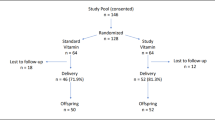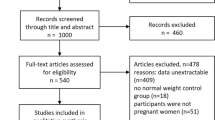Abstract
Objective: To investigate the possible beneficial effects of a micronutrient supplementation to apparently healthy pregnant women on maternal biological status and new born anthropometric characteristics.
Setting: Departments of Obstetric of the University Hospital of Grenoble (France) and Lyon (France), Laboratoire of Biology of Oxidative Stress, UFR de Pharmacie. Grenoble (France).
Study design: Double-blind, randomized placebo-controlled intervention trial.
Subjects: A total of 100 apparently healthy pregnant women were recruited at 14±2 weeks of gestation to delivery. At the end, they were 65 women to follow out the study.
Interventions: Daily consumption over gestation of a miconutrients supplement or placebo.
Main outcome measures: Plasma micronutrient levels and oxidative stress parameters were measured in mothers at 14 and 38 weeks of gestation. New born's anthropometric characteristics were measured at delivery.
Results: In the supplemented group, folic acid, vitamin C, E, B2, B6 and β-carotene levels were higher than in the placebo group. Oxidative stress parameters were not different between the groups. Birth weights were increased by 10% and the number of low newborn weights (<2700g) decreased significantly when the mother received the supplementation. Maternal plasma Zn levels were positively correlated to the newborn heights.
Conclusion: A regular intake of a micronutrient supplement at nutritional dose may be sufficient to improve micronutrient status of apparently healthy pregnant women and could prevent low birth weight of newborn.
Sponsorship: The supplement and placebo were supplied and the study was partially funded by BOIRON Pharmaceutical Company.
This is a preview of subscription content, access via your institution
Access options
Subscribe to this journal
Receive 12 print issues and online access
$259.00 per year
only $21.58 per issue
Buy this article
- Purchase on Springer Link
- Instant access to full article PDF
Prices may be subject to local taxes which are calculated during checkout

Similar content being viewed by others
References
Arikan S, Konukoglu D, Arikan C, Akcay T & Davas I (2001): Lipid peroxidation and antioxidant status in maternal and cord blood. Gynecol. Obstet. Invest. 51, 145–149.
Arnaud J, Bellanger J, Bienvenu F, Chappuis P & Favier A (1986): Recommended method for assaying serum zinc with flame atomic absorption. Ann. Biol. Clin. Paris 44, 77–87.
Arnaud J, Bellanger J, Chappuis P, Favier A & Galliot M (1985): Recommendations for the assay of serum copper by flame atomic absorption spectrometry. Ann. biol. Clin. 43, 297–318.
Arnaud J, Fortis I, Blachier S, Kia D & Favier A (1991): Simultaneous determination of retinol, α-tocopherol and β-carotene in serum by isocratic high performance liquid chromatography. J. Chromatogr. 572, 103–116.
Bates JH, Young S, Galway L, Traub AI & Hadden A (1997): Antioxidant status and lipid peroxidation in diabetic pregnancy. Br. J. Nutr. 78, 523–532.
Bayoumi RA & Rosalki SB (1976): Evaluation of methods of coenzyme activation of erythrocyte enzymes for detection of deficiency of Vitamins B1, B2 and B6. Clin Chem 22, 327–335.
Briefel RR, Bialostosky K, Kennedy-Stephenson J, McDowell MA, Ervin RB & Wright JD (2000): Zinc intake of the U.S. Population: findings from the third National Health and Nutrition Examination Survey, 1988–1994. J. Nutr. 130S, 1367S–1373S.
Brown KH, Peerson JM & Allen LH (1998): Effect of zinc supplementation on children's growth: a meta-analysis of intervention trials. Bibl. Nutr. Dieta 54, 76–83.
Cargnoni AA, Gregorini G, Ceconi C, Maiorca R & Ferrari R (1994): Lipid peroxidation in normal pregnancy and preeclampsia. Adv. Exp. Med. Biol. 336, 4203–4207.
Cederberg J, Siman CM & Eriksson UJ (2001): Combined treatment with vitamin E and vitamin C decreases oxidative stress and improves fetal outcome in experimental pregnancy. Pediatr. Res. 49, 755–762.
Chappell LC, Seed PT, Briley AL, Kelly FJ, Lee R, Hunt BJ, Parmar K, Shennan AH, Steer PJ & Poston L (1999): Effect of antioxidants on the occurrence of pre-eclampsia in women at increased risk: a randomized trial. Lancet 354, 810–816.
Doyle W, Crawford MA, Wynn HA & Wynn SW (1990): The association between maternal diet and birth dimensions. J. Nutr. Med. 1, 9–17.
Dreosti IE (2001): Zinc and the gene. Mutat. Res. 475, 161–167.
Eriksson UJ & Siman M (1996): Pregnant diabetic rats fed the antioxidant butylated hydroxytoluene, show decreased occurrence of malformation in offspring. Diabetes 45, 1407–1502.
Faure P & Lafond JL (1995): Measurement of plasma sulfhydryl and carbonyl groups as a possible indicator of protein oxidation. In Analysis of Free Radicals in Biology Systems, eds AE Favier, J Cadet, B Kalnyanaraman, M Fontecave & JL Pierre, pp 237–248. Basel, Boston, Berlin: Birkhäuser Press.
Fidanza AA & Fidanza R (1986): A nutrition study involving a group of pregnant women in Assisi. Int. J. Nutr. Res. 56, 373–380.
Ghisham FK, Said HM, Wilson PC, Murrell JE & Greene HC (1986): Intestinal transport of zinc and folic acid: a mutual inhibitory effect. Am. J. Clin. Nutr. 43, 258–262.
Giddens JB, Krug SK, Tsang RC, Guo S, Miodovnik M & Prada JA (2000): Pregnant adolescent women have similarly low intake of selected nutrients. J. Am. Diet. Assoc. 100, 1334–1340.
Godfrey KM & Parker DJP (2000): Fetal nutrition and adult disease. Am. J. Clin. Nutr. 71S, 1344S–1352S.
Hallberg L (1998): Does calcium interfere with iron absorption? Am. J. Clin. Nutr. 68, 3–4.
Halliwell B & Gutteridge JM (1990): Role of free radicals and catalytic metals ions in human disease: an overview. In Methods in Enzymology, eds Packer L & Glazer AN, Vol 186, pp 1–85. San Diego: Academic Press.
Handwerker SM, Altura BT & Altura BM (1996): Serum ionized magnesium and other electrolytes in the antenatal period of human pregnancy. J. Am. College Nutr. 15, 36–43.
Hubel CA, Roberts JM, Taylor N, Thomas J, Musci TJ & Mc Laughlin K (1989): Lipid peroxidation in pregnancy: new perspectives on preeclampsia. Am. J. Obstet. Gynecol. 161, 1025–1034.
Iyengar L & Rajalakshmi K (1975): Effect of folic acid supplement on birth weights of infants. Am. J. Obstet. Gynecol. 122, 332–336.
Jonnson B, Hauge B, Larsen MF & Hald F (1996): Zinc supplementation during pregnancy: a double blind randomized controlled trial. Acta Obstet. Gynecol. Scand. 75, 725–729.
King JC (2000): Physiology of pregnancy and nutrient metabolism. Am. J. Clin. Nutr. 71S, 1218S–1225S.
Ladipo OA (2000): Nutrition in pregnancy: mineral and vitamin supplements. Am. J. Clin. Nutr. 72S, 280S–290S.
Lira PIC, Ashworth A & Morris SS (1998): Effect of zinc supplementation on the morbidity, immune function, and growth of low-birth-weight, full-term infants in northeast Brazil. Am. J. Clin. Nutr. 68S, 418S–424S.
Lonnerdal B (1996): Iron–zinc–copper interactions. In Micronutrient Interactions: Impact on Child Health and Nutrition, ed. B Lonnerdal pp 3–10. Washington, DC: ILSI Press.
Makrides M & Crowther CA (2000): Magnesium supplementation in pregnancy. Cochrane Database System Rev. 2, CD000397.
Marklund S & Marklund G (1974): Involvement of superoxide anion radical in the autooxidation of pyrogallol as a convenient assay for superoxide dismutase. Eur. J. Biochem. 47, 469–474.
McIntire DE, Bloom SL, Casey BM & Leveno KJ (1999): Birth weight in relation to morbidity and mortality among newborn infants. N. Engl. J. Med. 340, 1234–1238.
Milne DB, Canfield WK, Mahako JR & Stanstead HH (1984): Effect of oral folic acid supplements on zinc, copper, and iron absorption and excretion. Am. J. Clin. Nutr. 39, 535–539.
Moser-Veillon PB & Reynolds RA (1990): Longitudinal study of pyridoxine and Zn supplementation of lactating women. Am. J. Clin. Nutr. 52, 135–141.
Nichoalds GE, Lawrence JD & Sauberlich HE (1974): Assessment of status of riboflavin nutriture by assay of erythrocyte glutathione reductase activity. Clin. Chem. 20, 624–628.
Osendarp SJ, Van Raaij MA, Darmstadt GL, Baqui AH, Hautvast GA & Fuchs GJ (2001): Zinc supplementation during pregnancy and effects on growth and morbidity in low birthweight infants: a randomized placebo controlled trial. Lancet 357, 1080–1085.
Poranen AK, Ekblad U, Uotila P & Ahotupa M (1996): Lipid peroxidation and antioxidant in normal and pre-eclamptic pregnancies. Placenta 17, 401–405.
Porter KG, McMaster D, Elmes ME & Love AHG (1977): Anemia and low serum-copper during zinc therapy. Lancet 2, 774.
Reddy MB & Cook JD (1997): Effect of calcium intake on nonheme-iron absorption a complete diet. Am. J. Clin. Nutr. 65, 1820–1825.
Richard MJ, Portal B, Meo J, Coudray C, Hadjian A & Favier A (1992): Malondialdehyde kit evaluated for determining plasma and lipoprotein fractions that react with thiobarbituric acid. Clin. Chem. 38, 704–709.
Rolschau J, Date J & Kristoffersen K (1981): Folic acid and iron during pregnancy. Gynecol. Obstet. Invest. 12, 294–304.
Romon M (1997): Les apports alimentaires suffisent-ils à couvrir les besoins de la grossesse? J. Gynécol. Obstét. Reprod. 26, 55–58.
Schwarz KB, Cox J, Sharma S, Witter F, Clement L, Sehnert S & Risby T (1995): Cigarette smoking is pro-oxidant in pregnant women regardless of antioxidant nutrient intake. J. Nutr. Environ. Med. 5, 225–234.
Shah D & Sachdev HPS (2001): Effect of gestational zinc deficiency on pregnancy outcomes: summary of observation studies and zinc supplementation trials. Br. J. Nutr. 85, S101–S108.
Speek AJ, Schrijver J & Schreus WHP (1984): Fluorimetric determination of total vitamin C in whole blood by high performance liquid chromatography with pre-column derivatization. J. Chromatogr. 305, 53–60.
Takehara Y, Yoshioka T & Sasaki J (1990): Changes in the levels of lipoperoxide and antioxidant factors in human placenta during pregnancy. Acta Med. 44, 103–107.
Tamura T, Olin KL, Goldenberg RL, Johnston KE, Dubard MB & Keen CL (2001): Plasma extracellular superoxide dismutase activity in apparently healthy pregnant women is not influenced by zinc supplementation. Biol. Trace Element Res. 80, 107–113.
UNICEF Report: The state of the world's children (1998): Malnutrition: causes, consequences, and solutions. Nutr. Rev. 56, 115–123.
Uotila J, Kirkkola AL, Rorarius M & Tuimala R (1994): The total peroxyl radical-trapping ability of plasma and cerebrospinal fluid in normal and preeclamptic parturients. Free Radical Biol. Med. 16, 581–590.
Whittaker P (1998): Iron and zinc interactions in humans. Am. J. Nutr. 68, 442S–446S.
Woods JR, Plessinger MA & Miller RK (2001): Vitamins C and E: missing links in preventing preterm premature of membranes? Am. J. Obstet. Gynecol. 185, 5–10.
Zavaleta N, Caufield LE & Garcia T (2000): Changes in iron status during pregnancy in Peruvian women receiving prenatal iron and folic acid supplements with or without zinc. Am. J. Clin. Nutr. 71, 956–961.
Author information
Authors and Affiliations
Corresponding author
Rights and permissions
About this article
Cite this article
Hininger, I., Favier, M., Arnaud, J. et al. Effects of a combined micronutrient supplementation on maternal biological status and newborn anthropometrics measurements: a randomized double-blind, placebo-controlled trial in apparently healthy pregnant women. Eur J Clin Nutr 58, 52–59 (2004). https://doi.org/10.1038/sj.ejcn.1601745
Received:
Revised:
Accepted:
Published:
Issue Date:
DOI: https://doi.org/10.1038/sj.ejcn.1601745
Keywords
This article is cited by
-
Clinical Practice Guidelines for Childbearing Female Candidates for Bariatric Surgery, Pregnancy, and Post-partum Management After Bariatric Surgery
Obesity Surgery (2019)
-
Oxidative stress markers and micronutrients in maternal and cord blood in relation to neonatal outcome
European Journal of Clinical Nutrition (2014)
-
The Effects of Prenatal Use of Folic Acid and Other Dietary Supplements on Early Child Development
Maternal and Child Health Journal (2008)
-
Relationship between dietary folate intakes, maternal plasma total homocysteine and B-vitamins during pregnancy and fetal growth in Japan
European Journal of Nutrition (2007)
-
Age-related oxidative stress and antioxidant parameters in middle-aged and older European subjects: the ZENITH study
European Journal of Clinical Nutrition (2005)



